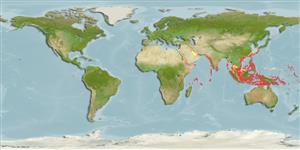Teleostei (teleosts) >
Kurtiformes (Nurseryfishes, cardinalfishes.) >
Apogonidae (Cardinalfishes) > Apogoninae
Etymology: Rhabdamia: Greek, rhabdos = stick + Greek, amia = a kind of shark (Ref. 45335).
More on author: Bleeker.
Environment: milieu / climate zone / depth range / distribution range
Ecology
Marine; reef-associated; depth range 3 - 91 m (Ref. 86942). Tropical; 32°N - 12°S
Indo-West Pacific.
Length at first maturity / Size / Weight / Age
Maturity: Lm 3.6 range ? - ? cm
Max length : 7.4 cm TL male/unsexed; (Ref. 101568)
Dorsal spines (total): 7; Dorsal soft rays (total): 9; Anal spines: 2; Anal soft rays: 12 - 13. This species is distinguished by the following characters: bluish longitudinal stripe on the middle of the body; translucent white or pink, silvery on head and abdomen; caudal peduncle sometimes with a posteriorly placed black spot; characterized further by one or both caudal fin lobes having black tip; greatest depth of body 3.3-3.6 in SL (Ref. 90102).
Inhabits lagoon and coastal reefs, among corals and rocks (Ref. 4329, 127962). Lives sympatrically with A. notatus (Ref. 76833). Forms large schools (Ref. 559). Feeds during the day in currents above reefs as well as at night (Ref. 48635).
Distinct pairing during courtship and spawning (Ref. 205).
Yoshida, T., K. Mabuchi and H. Motomura, 2018. Rhabdamia novaluna, a new species of cardinalfish (Perciformes: Apogonidae) from the western Pacific Ocean, with comments on the synonymy of Rhabdamia gracilis. Ichthyol. Res. 66(1):129-139. (Ref. 129520)
IUCN Red List Status (Ref. 130435)
Threat to humans
Harmless
Human uses
Tools
Special reports
Download XML
Internet sources
Estimates based on models
Preferred temperature (Ref.
123201): 25 - 29, mean 28.1 °C (based on 1064 cells).
Phylogenetic diversity index (Ref.
82804): PD
50 = 0.5156 [Uniqueness, from 0.5 = low to 2.0 = high].
Bayesian length-weight: a=0.01072 (0.00607 - 0.01892), b=3.09 (2.94 - 3.24), in cm total length, based on LWR estimates for this species & (Sub)family-body (Ref.
93245).
Trophic level (Ref.
69278): 3.3 ±0.26 se; based on food items.
Resilience (Ref.
120179): High, minimum population doubling time less than 15 months (K=2.67).
Fishing Vulnerability (Ref.
59153): Low vulnerability (10 of 100).
Nutrients (Ref.
124155): Calcium = 208 [107, 551] mg/100g; Iron = 1.6 [0.8, 2.9] mg/100g; Protein = 18.8 [17.4, 20.1] %; Omega3 = 0.178 [0.073, 0.441] g/100g; Selenium = 60 [21, 150] μg/100g; VitaminA = 49.2 [12.2, 196.0] μg/100g; Zinc = 3.08 [1.80, 4.77] mg/100g (wet weight);
